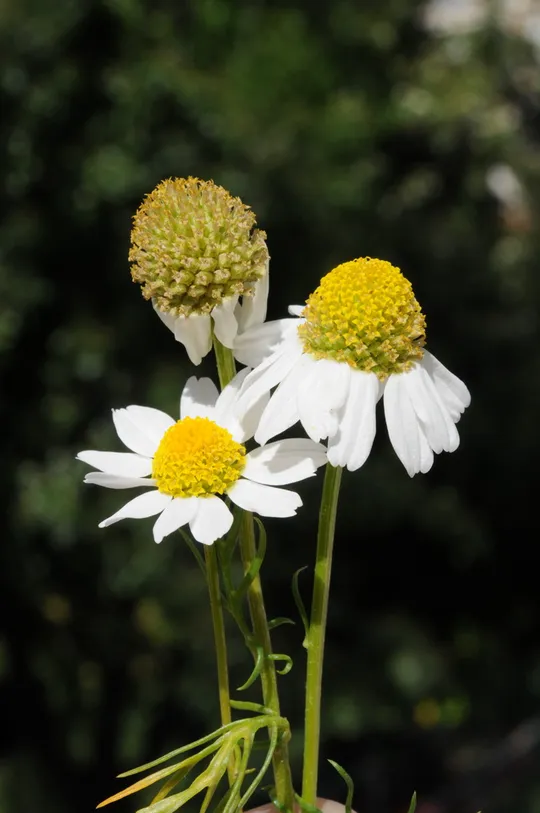Anthemis philistea



Anthemis philistea grows in Pleshet
and in the western Negev. It also appears in the Gaza Strip. The species was
documented at 39 sites, although it is estimated that there are more than 80
sites, from the area of Nes Tsiona and the Palmahim sands in the north to the Hevel
Shalom region in the western Negev.
Anthemis philistea is a typical plant
of sand fields, sandy calcareous limestone and sandy red loam in the southern
Mediterranean region on the coastal plain where annual precipitation ranges between
200 and 500 mm.
The genus Anthemis includes about
210 species whose speciation center is in Europe, the Mediterranean Basin and
the Irano-Turanian region in Western Asia. This is the largest genus in the sub-tribe
Anthemideae in the family Asteraceae (Compositae) whose
main distribution is in Africa, Asia and Europe. It also includes the genera Achillea,
Matricaria, Anacyclus and Ormensis. This tribe is distinguished from
the Chrysanthemum sub-tribe by the presence of a paleate receptacle. The genus Anthemis is
characterized by its pinnately dissected leaves, involucral bracts in the form
of thick, hard membranes with a thin membranous labium. The styles are
truncated and paintbrush-like; its foliage has a characteristic odor; and its achenes
lack a pappus. The closest genera to Anthemis
are Ormensis and Anacyclus. These genera differ from
it in their receptacle bracts, flowers and achenes. Ormensis differs
from Anthemis
by the corolla tube that extends beyond its base and surrounds the achene on
one side. Ormensis differs from Anthemis mainly in its corolla tube and
its winged achene. The center of diversity of the genus Anthemis is in Turkey, in the Caucasus
and in the Fertile Crescent. Seventy-three different species grow in Turkey and
Iran and 38 species in the Levant (Syria, Lebanon, Israel and Jordan). Turkey
alone has 52 different species of Anthemis and in Israel, there are 23 (not including the
Hermon). Most of the species in the genus are annuals, including several
species that are known to have spread to distant continents. Most of the Anthemis species have both ray and disc
florets in their capitulum. The ray flowers are female, and because they are
the first to open in each inflorescence, they can only cross-pollinate. The disc
flowers are androgynous and have the potential to produce seeds by self-pollination
as well. In a fertility study conducted on several dominant Anthemis species in Israel, six of the
species tested were incapable of self-pollination (Yeivin, 1971). There are only
few species in the genus that do not have ray flowers at all, e.g., A.
tinctoria. It is possible that the loss of ray flowers occurs when conditions
are difficult and the probability of cross-pollination is low.
A.
philistea was described by Boissier in the 19th century from
Philistia (hence the plant’s name). Bolus in the new Flora of Egypt brings this
taxon as a synonym of both A.
eliezrae
and A. indurata; i.e., Bolus treats it as synonymous to A. indurata,
which was previously described from the Sinai desert. Eig in his monograph on Anthemis (Eig 1938),
transferred A.
philistea to the
status of a subspecies of A.
leucanthemifolia as did Feinbrun in the Flora Palaestina.
·
In Israel Anthemis philistea is restricted to only two regions, but its distribution seems to be
stable. Although there are relatively numerous, the future of some of the
populations is uncertain.
·
On most of the sites,
A.
philistea is common and creates dominant local patches.
·
Anthropogenic development
in the coastal plain and the western Negev threaten the populations at all
sites.
·
Some of the A. philistea
sites are protected in nature reserves in Pleshet: Palmahim, Humra Ruins, White
Acacia Nature Reserve, Gvar'am Ridge, Nir Am and Carmia.
·
The species is endemic
to a small geographical area in Israel, Gaza and northern Sinai and its local
threat status is equivalent to its global one.
Efforts should be made to establish additional declared
nature reserves in sand and sandy calcareous limestone expanses in Pleshet, in
the Rehovot-Givat Brenner, Nes Tsiona and Nitsanim areas and in the western
Negev in the Hevel Shalom sands.
Anthemis philistea is an endemic
species to southern Lebanon, Israel, the Gaza Strip and the Sinai coast.
Anthemis philistea is an annual plant of
sandy, sandy calcareous sandstone and sandy red loam expanses whose
distribution is restricted to Pleshet and the western Negev sands. It is endemic
to Israel and the sands of northern Sinai. While the local populations are
large, its habitat is threatened by development. Conservation efforts should be
directed to at protecting the habitat.
ייבין זיוה, 1971, אבולוציה וטקסונומיה בסוג קחוון, משפחת המורכבים. האוניברסיטה העברית בירושלים (עבודת דוקטורט).
Eig, A. 1938, Taxonomic studies on the ental species of the genus Anthemis. Palestine J.of Botany, 1,(2),161-225.
Current Occupancy Map
| 1000 squre meter pixel | 5000 squre meter pixel | 10000 squre meter pixel | |
|---|---|---|---|
| number of observations | 0 | 0 | 0 |
| in total pixels | 0 | 0 | 0 |
| Family | Asteraceae |
| Classification | On the endangered species list |
| Ecosystem | Coastal area |
| Chorotype | Eastern Mediterranean |
| Conservation Site | Calcareous sandstone hills between Wadi Tiah to Nabi Mer'i lookout near the Gaza Strip border |
| Rarity |
1
1
6
|
|---|---|
| Vulnerability |
0
2
4
|
| Attractiveness |
0
0
4
|
| Endemism |
0
4
4
|
| Red number |
1
3.7
10
|
| Peripherality | 0 |
| IUCN category | DD EW EX LC CR EN VU NT |
| Threat Definition according to the red book | Vulnerable |
 Based on:
Based on:






